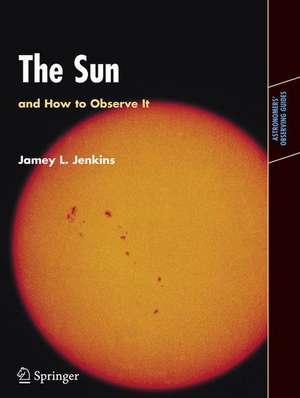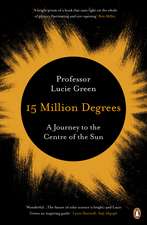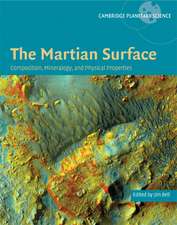The Sun and How to Observe It: Astronomers' Observing Guides
Autor Jamey L. Jenkinsen Limba Engleză Paperback – 8 ian 2009
In Part 2, the book details the techniques for observing and imaging the Sun with commercially-available equipment. The many recent advances in optical equipment now allow amateur astronomers to observe phenomena that until recently could only be seen with the extremely expensive equipment available at universities and research observatories – notably H-alpha and Calcium-K telescopes.
This is a completely up-to-date solar observing book, while providing the science background necessary for an understanding of the observations with the latest equipment. It also features the most complete solar observing and imaging guide available.
Din seria Astronomers' Observing Guides
-
 Preț: 183.23 lei
Preț: 183.23 lei -
 Preț: 196.41 lei
Preț: 196.41 lei -
 Preț: 189.37 lei
Preț: 189.37 lei -
 Preț: 193.12 lei
Preț: 193.12 lei -
 Preț: 184.28 lei
Preț: 184.28 lei -
 Preț: 329.89 lei
Preț: 329.89 lei -
 Preț: 273.58 lei
Preț: 273.58 lei -
 Preț: 275.79 lei
Preț: 275.79 lei -
 Preț: 254.46 lei
Preț: 254.46 lei -
 Preț: 251.37 lei
Preț: 251.37 lei -
 Preț: 285.68 lei
Preț: 285.68 lei -
 Preț: 213.79 lei
Preț: 213.79 lei -
 Preț: 254.90 lei
Preț: 254.90 lei -
 Preț: 298.02 lei
Preț: 298.02 lei -
 Preț: 217.51 lei
Preț: 217.51 lei -
 Preț: 300.38 lei
Preț: 300.38 lei -
 Preț: 270.71 lei
Preț: 270.71 lei -
 Preț: 345.09 lei
Preț: 345.09 lei -
 Preț: 342.13 lei
Preț: 342.13 lei -
 Preț: 246.30 lei
Preț: 246.30 lei -
 Preț: 256.78 lei
Preț: 256.78 lei -
 Preț: 210.90 lei
Preț: 210.90 lei
Preț: 280.19 lei
Nou
Puncte Express: 420
Preț estimativ în valută:
53.62€ • 57.33$ • 44.70£
53.62€ • 57.33$ • 44.70£
Carte disponibilă
Livrare economică 28 martie-11 aprilie
Preluare comenzi: 021 569.72.76
Specificații
ISBN-13: 9780387094977
ISBN-10: 0387094970
Pagini: 210
Ilustrații: XIV, 206 p.
Dimensiuni: 189 x 246 x 13 mm
Greutate: 0.45 kg
Ediția:2009
Editura: Springer
Colecția Springer
Seria Astronomers' Observing Guides
Locul publicării:New York, NY, United States
ISBN-10: 0387094970
Pagini: 210
Ilustrații: XIV, 206 p.
Dimensiuni: 189 x 246 x 13 mm
Greutate: 0.45 kg
Ediția:2009
Editura: Springer
Colecția Springer
Seria Astronomers' Observing Guides
Locul publicării:New York, NY, United States
Public țintă
Popular/generalCuprins
Acknowledgements.- Introduction.- The Sun, Yesterday and Today.- Some Basics of Solar Observing.- Observing the White Light Sun.- White Light Solar Features.- Recording White Light Observations.- Observing the Monochromatic Sun.- Monochromatic Solar Features.- Solar Photography.- Where Do You Go from Here?- Appendix A: Resources.- Appendix B: Glossary of Solar-Related Terms.- Appendix C: Daily Solar Ephemeris, July 2008-January 2012.
Recenzii
From the reviews:
"Jenkins is an American amateur observer and he has written a very interesting book full of information for the solar enthusiast. … The author describes how a solar hydrogen-alpha filter works – very interesting to the beginner, and the old-time observer … . it is very well illustrated, with many of the images supplied by the author himself. … I recommend this book. … will be a good guide to observing our nearest star." (Brian Halls, Astronomy Now, August, 2009)
"The author is quite obviously an experienced solar observer and imager, contributing to the AAVSO Sunspot Programme since I990. … This book is primarily a practical guide to observing and imaging solar features in white light … and the K-line. There is a detailed discussion of the types of telescope suitable for solar observing as well as lenses and filters. … I found this book enjoyable and easy to read, providing a comprehensive practical guide to solar observing in one volume." (Lyn Smith, The Observatory, Vol. 129 (1212), October, 2009)
"Jenkins is an American amateur observer and he has written a very interesting book full of information for the solar enthusiast. … The author describes how a solar hydrogen-alpha filter works – very interesting to the beginner, and the old-time observer … . it is very well illustrated, with many of the images supplied by the author himself. … I recommend this book. … will be a good guide to observing our nearest star." (Brian Halls, Astronomy Now, August, 2009)
"The author is quite obviously an experienced solar observer and imager, contributing to the AAVSO Sunspot Programme since I990. … This book is primarily a practical guide to observing and imaging solar features in white light … and the K-line. There is a detailed discussion of the types of telescope suitable for solar observing as well as lenses and filters. … I found this book enjoyable and easy to read, providing a comprehensive practical guide to solar observing in one volume." (Lyn Smith, The Observatory, Vol. 129 (1212), October, 2009)
Notă biografică
Jamey Jenkins has been a regular contributor to the Sunspot Program of the American Association of Variable Star Observers (AAVSO) since 1990 and an active observer for the Association of Lunar and Planetary Observers (ALPO) Solar Section since 1998. He has been Assistant Section Coordinator of that group for the last three years. He has also published numerous articles and images in Sky & Telescope and The Strolling Astronomer.
Textul de pe ultima copertă
Without the Sun, all life on Earth would perish. But what exactly do we know about this star that lights, heats, and powers Earth?
Actually, we know quite a lot, thanks mainly to a host of eager solar observers. Looking directly at the Sun is EXTREMELY hazardous. But many astronomers, both professional and amateur, have found ways to view the Sun safely to learn about it.
You, too, can view the Sun in all of its glorious detail. Some of the newest, most exciting telescopes on the market are affordable to amateur astronomers or even just curious sky watchers, and with this guide to what the Sun has to offer, including sunspots, prominences, and flares, plus reviews of the latest instruments for seeing and capturing images of the Sun, you can contribute to humankind’s knowledge of this immense ball of glowing gases that gives us all life.
For a complete guide to Sun viewing, see also Total Solar Eclipses and How to Observe Them (2007) by Martin Mobberley in this same series.
Actually, we know quite a lot, thanks mainly to a host of eager solar observers. Looking directly at the Sun is EXTREMELY hazardous. But many astronomers, both professional and amateur, have found ways to view the Sun safely to learn about it.
You, too, can view the Sun in all of its glorious detail. Some of the newest, most exciting telescopes on the market are affordable to amateur astronomers or even just curious sky watchers, and with this guide to what the Sun has to offer, including sunspots, prominences, and flares, plus reviews of the latest instruments for seeing and capturing images of the Sun, you can contribute to humankind’s knowledge of this immense ball of glowing gases that gives us all life.
For a complete guide to Sun viewing, see also Total Solar Eclipses and How to Observe Them (2007) by Martin Mobberley in this same series.
Caracteristici
Contains the latest, up-to-date, information on techniques that amateur astronomers can use to observe the Sun Explains the very latest thinking on solar physics in mostly many non-mathematical terms Includes details on the newest Hydrogen-alpha and Calcium-K line telescopes now available at affordable prices










